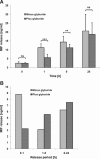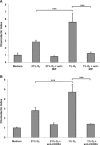Hypoxia-induced endothelial secretion of macrophage migration inhibitory factor and role in endothelial progenitor cell recruitment
- PMID: 20178462
- PMCID: PMC3922388
- DOI: 10.1111/j.1582-4934.2010.01041.x
Hypoxia-induced endothelial secretion of macrophage migration inhibitory factor and role in endothelial progenitor cell recruitment
Abstract
Macrophage migration inhibitory factor (MIF) is a pleiotropic inflammatory cytokine that was recently identified as a non-cognate ligand of the CXC-family chemokine receptors 2 and 4 (CXCR2 and CXCR4). MIF is expressed and secreted from endothelial cells (ECs) following atherogenic stimulation, exhibits chemokine-like properties and promotes the recruitment of leucocytes to atherogenic endothelium. CXCR4 expressed on endothelial progenitor cells (EPCs) and EC-derived CXCL12, the cognate ligand of CXCR4, have been demonstrated to be critical when EPCs are recruited to ischemic tissues. Here we studied whether hypoxic stimulation triggers MIF secretion from ECs and whether the MIF/CXCR4 axis contributes to EPC recruitment. Exposure of human umbilical vein endothelial cells (HUVECs) and human aortic endothelial cells (HAoECs) to 1% hypoxia led to the specific release of substantial amounts of MIF. Hypoxia-induced MIF release followed a biphasic behaviour. MIF secretion in the first phase peaked at 60 min. and was inhibited by glyburide, indicating that this MIF pool was secreted by a non-classical mechanism and originated from pre-formed MIF stores. Early hypoxia-triggered MIF secretion was not inhibited by cycloheximide and echinomycin, inhibitors of general and hypoxia-inducible factor (HIF)-1α-induced protein synthesis, respectively. A second phase of MIF secretion peaked around 8 hrs and was likely due to HIF-1α-induced de novo synthesis of MIF. To functionally investigate the role of hypoxia-inducible secreted MIF on the recruitment of EPCs, we subjected human AcLDL(+) KDR(+) CD31(+) EPCs to a chemotactic MIF gradient. MIF potently promoted EPC chemotaxis in a dose-dependent bell-shaped manner (peak: 10 ng/ml MIF). Importantly, EPC migration was induced by supernatants of hypoxia-conditioned HUVECs, an effect that was completely abrogated by anti-MIF- or anti-CXCR4-antibodies. Thus, hypoxia-induced MIF secretion from ECs might play an important role in the recruitment and migration of EPCs to hypoxic tissues such as after ischemia-induced myocardial damage.
© 2011 The Authors Journal of Cellular and Molecular Medicine © 2011 Foundation for Cellular and Molecular Medicine/Blackwell Publishing Ltd.
Figures







Similar articles
-
Macrophage migration inhibitory factor is a potential inducer of endothelial progenitor cell mobilization after flap operation.Surgery. 2012 Feb;151(2):268-277.e1. doi: 10.1016/j.surg.2010.10.008. Epub 2010 Dec 30. Surgery. 2012. PMID: 21193209
-
Differential roles of angiogenic chemokines in endothelial progenitor cell-induced angiogenesis.Basic Res Cardiol. 2013 Jan;108(1):310. doi: 10.1007/s00395-012-0310-4. Epub 2012 Nov 9. Basic Res Cardiol. 2013. PMID: 23184390 Free PMC article.
-
Levels of macrophage migration inhibitory factor and glucocorticoids in chronic wound patients and their potential interactions with impaired wound endothelial progenitor cell migration.Wound Repair Regen. 2012 Sep-Oct;20(5):707-14. doi: 10.1111/j.1524-475X.2012.00817.x. Epub 2012 Jul 19. Wound Repair Regen. 2012. PMID: 22812717
-
Hypoxia inducible factor-1 alpha, endothelial progenitor cells, monocytes, cardiovascular risk, wound healing, cobalt and hydralazine: a unifying hypothesis.Curr Drug Targets. 2008 May;9(5):422-35. doi: 10.2174/138945008784221215. Curr Drug Targets. 2008. PMID: 18473772 Review.
-
MIF and CD74 - suitability as clinical biomarkers.Mini Rev Med Chem. 2014;14(14):1125-31. doi: 10.2174/1389557515666150203143317. Mini Rev Med Chem. 2014. PMID: 25643609 Review.
Cited by
-
Resistance to immune checkpoint therapies by tumour-induced T-cell desertification and exclusion: key mechanisms, prognostication and new therapeutic opportunities.Br J Cancer. 2023 Oct;129(8):1212-1224. doi: 10.1038/s41416-023-02361-4. Epub 2023 Jul 15. Br J Cancer. 2023. PMID: 37454231 Free PMC article. Review.
-
Vascular endothelial growth factor signaling in hypoxia and inflammation.J Neuroimmune Pharmacol. 2014 Mar;9(2):142-60. doi: 10.1007/s11481-014-9531-7. Epub 2014 Mar 9. J Neuroimmune Pharmacol. 2014. PMID: 24610033 Free PMC article. Review.
-
Hsp90-stabilized MIF supports tumor progression via macrophage recruitment and angiogenesis in colorectal cancer.Cell Death Dis. 2021 Feb 4;12(2):155. doi: 10.1038/s41419-021-03426-z. Cell Death Dis. 2021. PMID: 33542244 Free PMC article.
-
Baicalin Relieves Glaesserella parasuis-Triggered Immunosuppression Through Polarization via MIF/CD74 Signaling Pathway in Piglets.Biomolecules. 2025 Apr 29;15(5):640. doi: 10.3390/biom15050640. Biomolecules. 2025. PMID: 40427533 Free PMC article.
-
Chemokine contribution in stem cell engraftment into the infarcted myocardium.Curr Stem Cell Res Ther. 2013 Jul;8(4):278-83. doi: 10.2174/1574888x11308040003. Curr Stem Cell Res Ther. 2013. PMID: 23547962 Free PMC article. Review.
References
-
- Bernhagen J, Calandra T, Bucala R. Regulation of the immune response by macrophage migration inhibitory factor: biological and structural features. J Mol Med. 1998;76:151–61. - PubMed
-
- Morand EF, Leech M, Bernhagen J. MIF: a new cytokine link between rheumatoid arthritis and atherosclerosis. Nat Rev Drug Discov. 2006;5:399–410. - PubMed
-
- Zernecke A, Bernhagen J, Weber C. Macrophage migration inhibitory factor in cardiovascular disease. Circulation. 2008;117:1594–602. - PubMed
-
- Bernhagen J, Krohn R, Lue H, et al. MIF is a noncognate ligand of CXC chemokine receptors in inflammatory and atherogenic cell recruitment. Nat Med. 2007;13:587–96. - PubMed
Publication types
MeSH terms
Substances
LinkOut - more resources
Full Text Sources
Other Literature Sources
Medical
Miscellaneous

